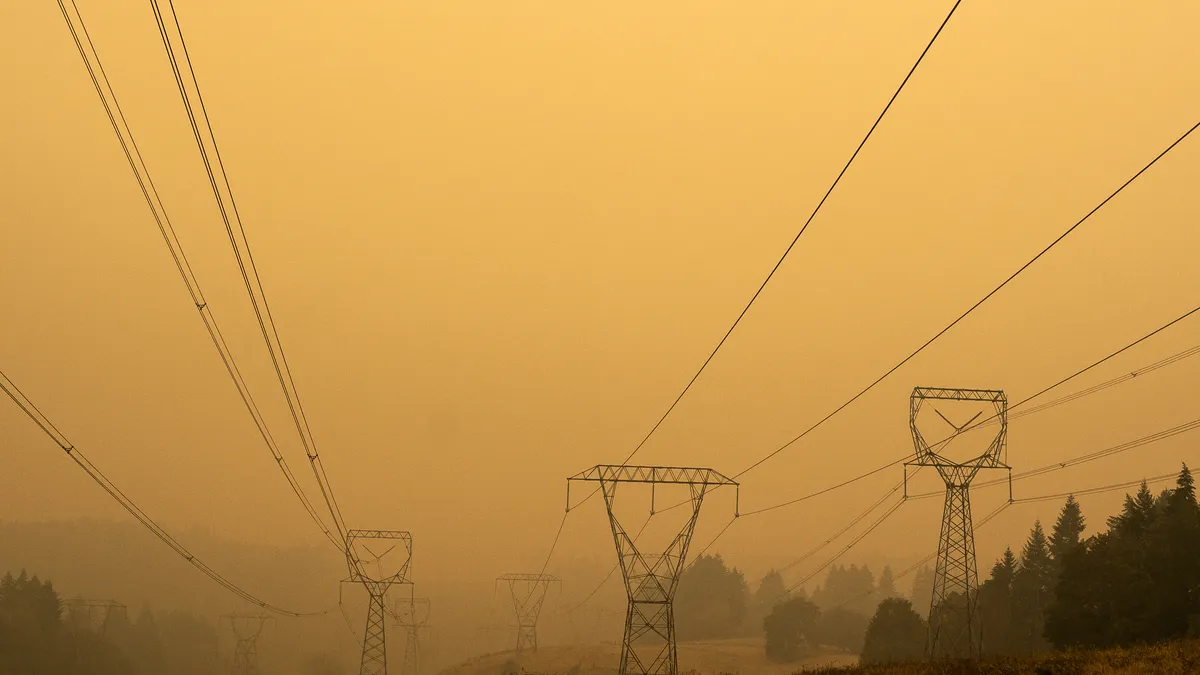Dive Brief:
- The Oregon Public Utility Commission (PUC) last week issued a series of temporary rules to govern utility deployments of public safety power shutoffs (PSPS) as well as reporting requirements for the 2021 wildfire season.
- The rules, which will apply to investor-owned utilities like Portland General Electric and Pacific Power, will remain in effect until mid-November. Regulators are simultaneously crafting permanent rules in collaboration with the utilities and communities.
- Deploying safety shut-offs is an extreme decision, Commissioner Letha Tawney acknowledged during a meeting last week. "At the same time, extreme weather conditions — especially high wind — tests even the best built and maintained electrical systems," she added.
Dive Insight:
Wildfires burned nearly one million acres in Oregon in 2020, according to the PUC, and this year, the state's Department of Forestry officially announced the beginning of fire season for certain areas this month — the earliest in over 40 years. The combination of utility infrastructure as well as the accumulation of dead trees across Oregon, is creating "a real, literal tinderbox, that requires sometimes an extreme response," Tawney said.
"There are no easy or simple or cheap solutions to adapting this entire grid to a changing climate and the continued human development in the wildland-urban interface," she added.
Last year, the lack of communication and processes around PSPS deployment caused larger challenges for the state, according to a PUC staff memo, leading regulators to conclude that there is a need for clearly defined communication protocols between utilities, state agencies and the public.
"Without the adoption of these rules, there is a substantial likelihood that preventable injury to people and property will occur," the memo stated.
The PUC's official order on the temporary rules will likely be issued early next week, PUC spokesperson Kandi Young said in an email. But the staff memo outlines the overall structure of the rules. The PSPS rules are categorized into a few key buckets, according to a presentation prepared by commission staff: preparing for PSPS events, with a focus transparency and getting data to the right parties, including telecommunications companies; expectations for utilities as they are initiating a PSPS, including coordinating with local entities; and reporting rules for after the power is restored.
Public safety power shutoffs have also been deployed by utilities in California to prevent their power lines from sparking wildfires during risky weather conditions. However, regulators in that state have been raising concerns about the impacts of these shutoffs on customers, and especially those with medical vulnerabilities.
In late 2019, Pacific Gas & Electric, Southern California Edison and San Diego Gas & Electric shut off the power to more than 2.1 million households, businesses and other customers because of high fire risk conditions. But the California Public Utilities Commission (CPUC) opened an investigation into these shutoffs shortly after and the agency recently released a proposal that, if approved, would find that the three utilities failed to comply with regulatory guidelines when they switched off the power
It isn't surprising to see utilities outside California turning to proactive de-energization during times of high fire risk, according to Steven Weissman, lecturer at the University of California, Berkeley's Goldman School of Public Policy and former administrative law judge at the CPUC. With drought conditions and climate changes pervasive across the Western U.S., "they are going to have to figure out how to protect against utility-triggered wildfires," he said.
Proactive power shut-offs have been unpopular in California — but so are wildfires, and policy-makers and utilities need to figure out how to balance those factors, Weissman said. And there's always things that can be done to make the process less painful, like providing adequate notice and accurate websites where people can figure out if a shutoff will affect them, more efficient processes to bring back the power after a PSPS, providing mobile power units, and so on.
"There are many, many different steps that can mitigate the pain related to the power shutoffs, and it's certainly everybody's responsibility — regulators and utilities — to deploy as many of those strategies as possible," Weissman said.
Pacific Power parent company PacifiCorp welcomes the Oregon PUC's temporary guidance, spokesperson Drew Hanson said in an email, adding that the company has a long history of planning for and defending against wildfires in the six Western states it operates in.
"We also continue to evolve our practices by expanding investments in new areas not typically associated with energy services providers. We've added expertise in terms of weather forecasting and predictive modeling by making these in-house capabilities, so we can advance our readiness," Hanson said.
Portland General Electric deployed its first PSPS in September 2020 as a last-resort safety measure and at the time, implemented an extensive communications and information campaign to prepare the public, utility spokesperson Andrea Platt said in an email.
"That experience provided crucial insights that have helped inform our engagement with Oregon's Public Utility Commission in this temporary rulemaking process. We're readying to meet the requirements of the temporary rules and look forward to continued engagement on the permanent rules," Platt added.















